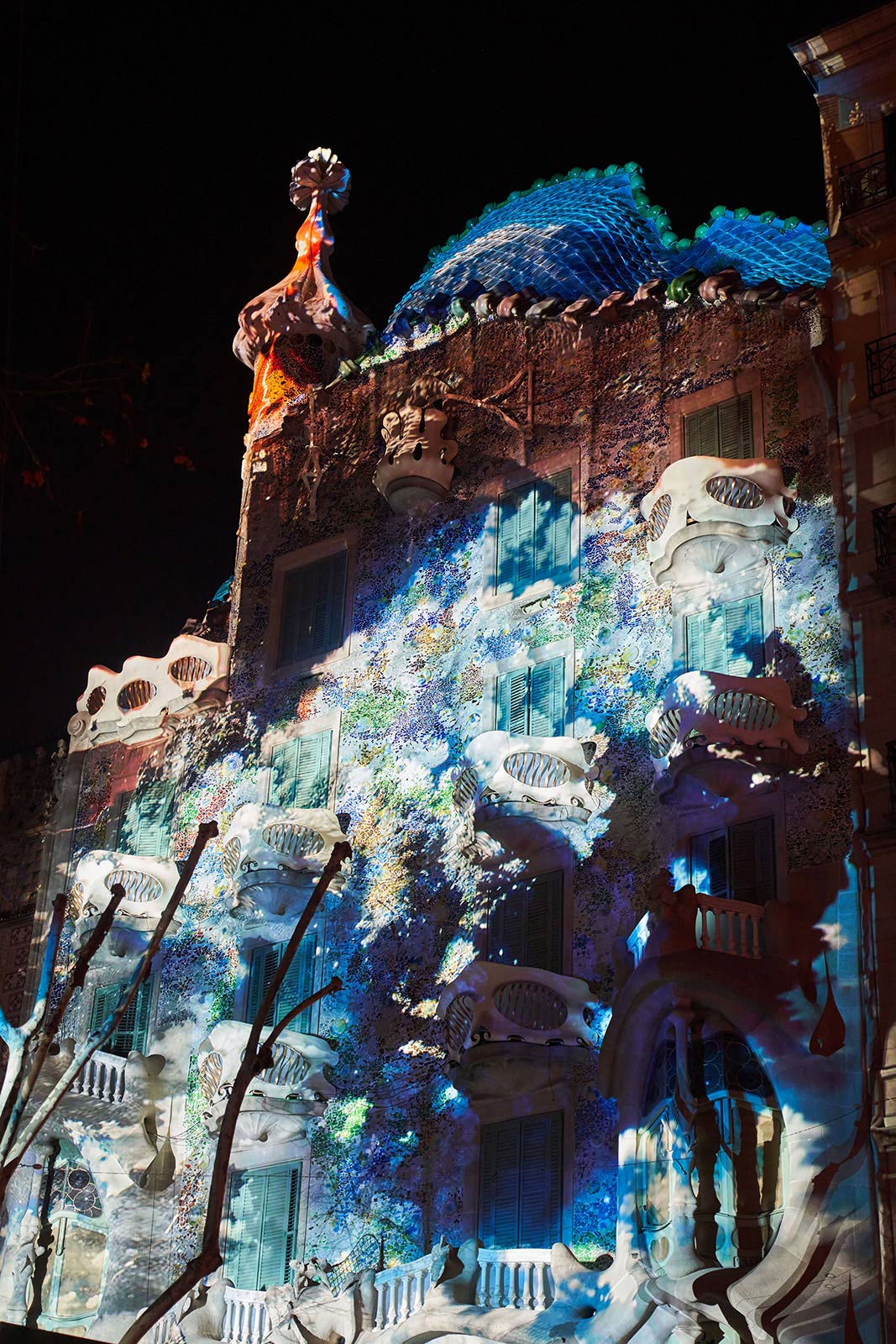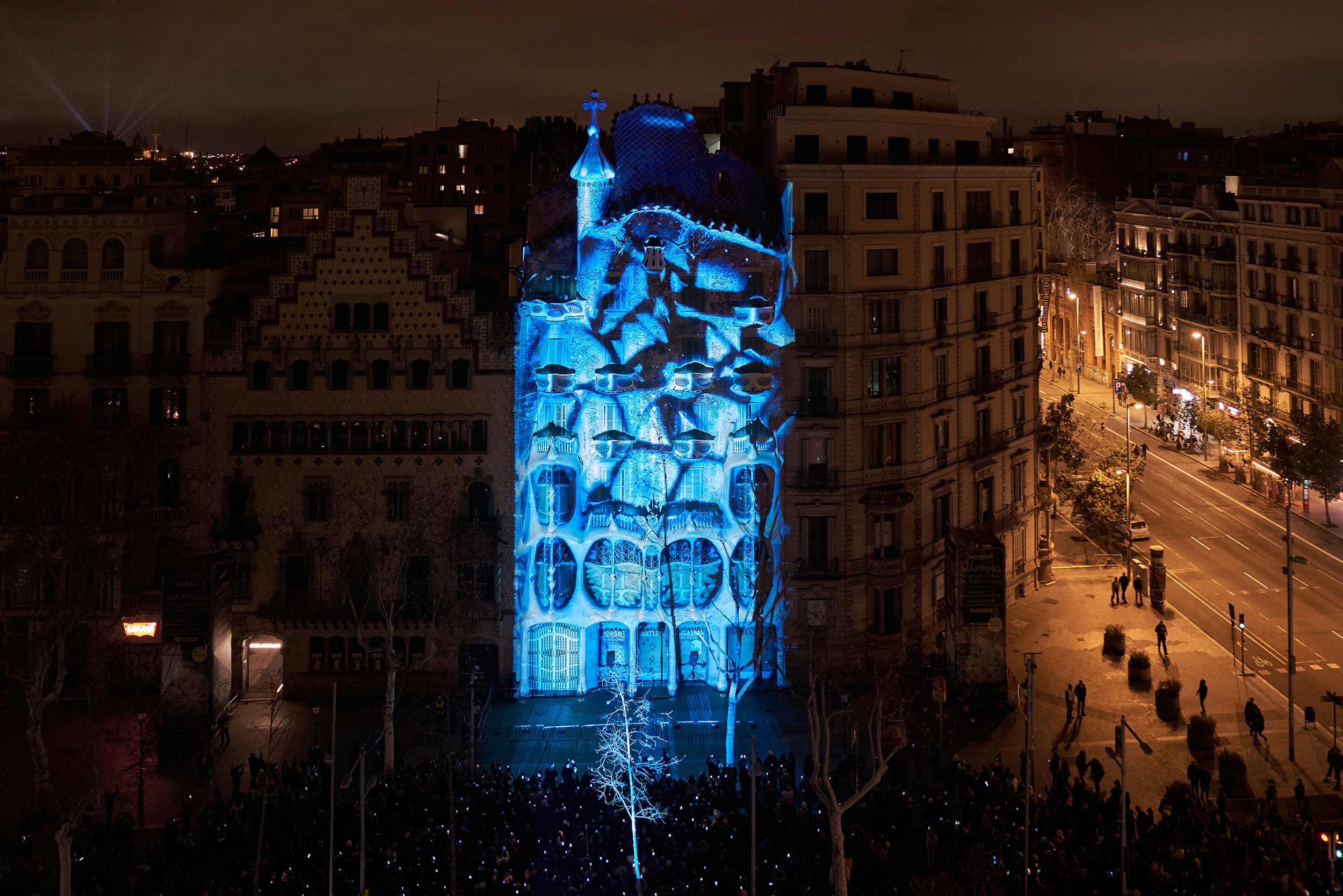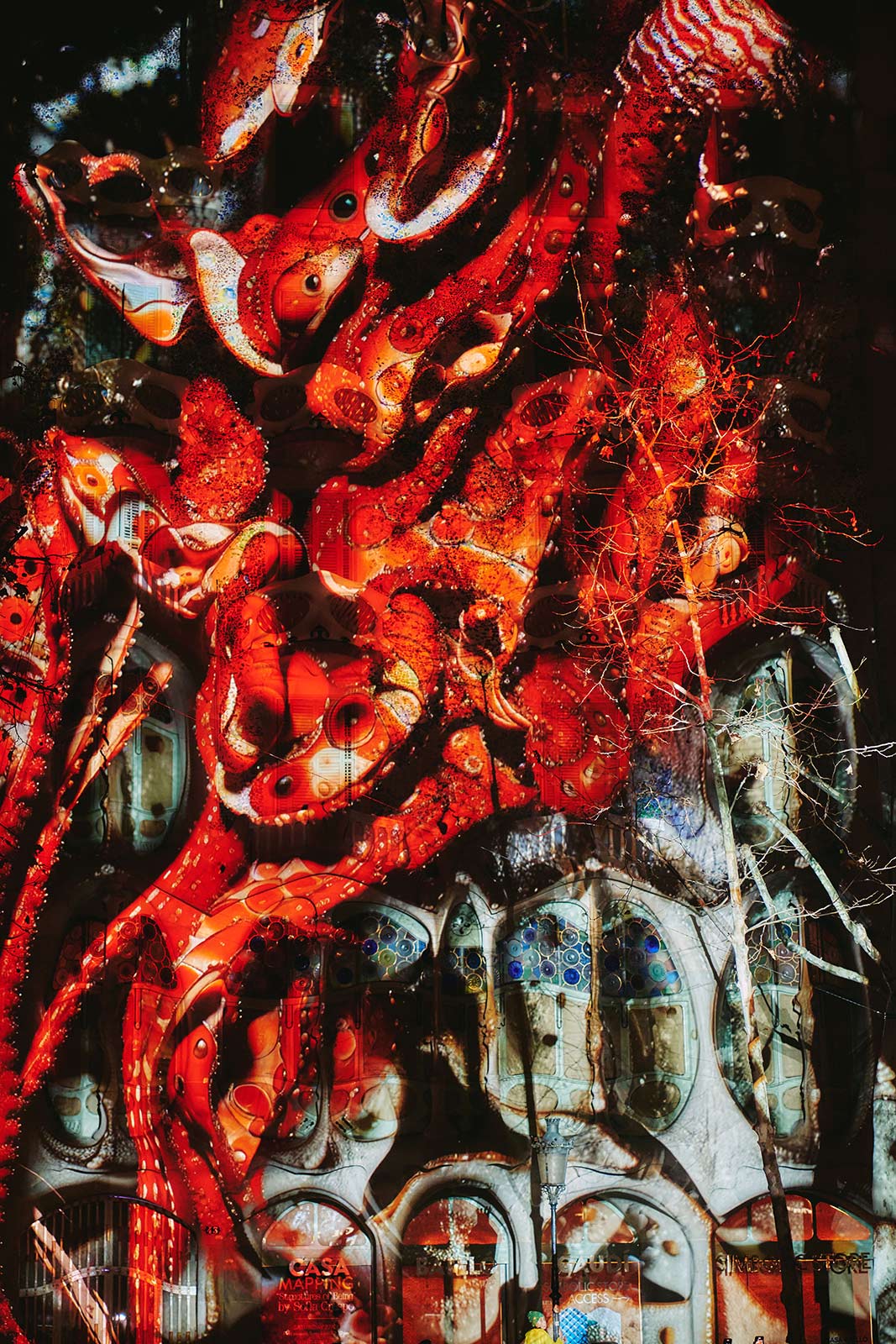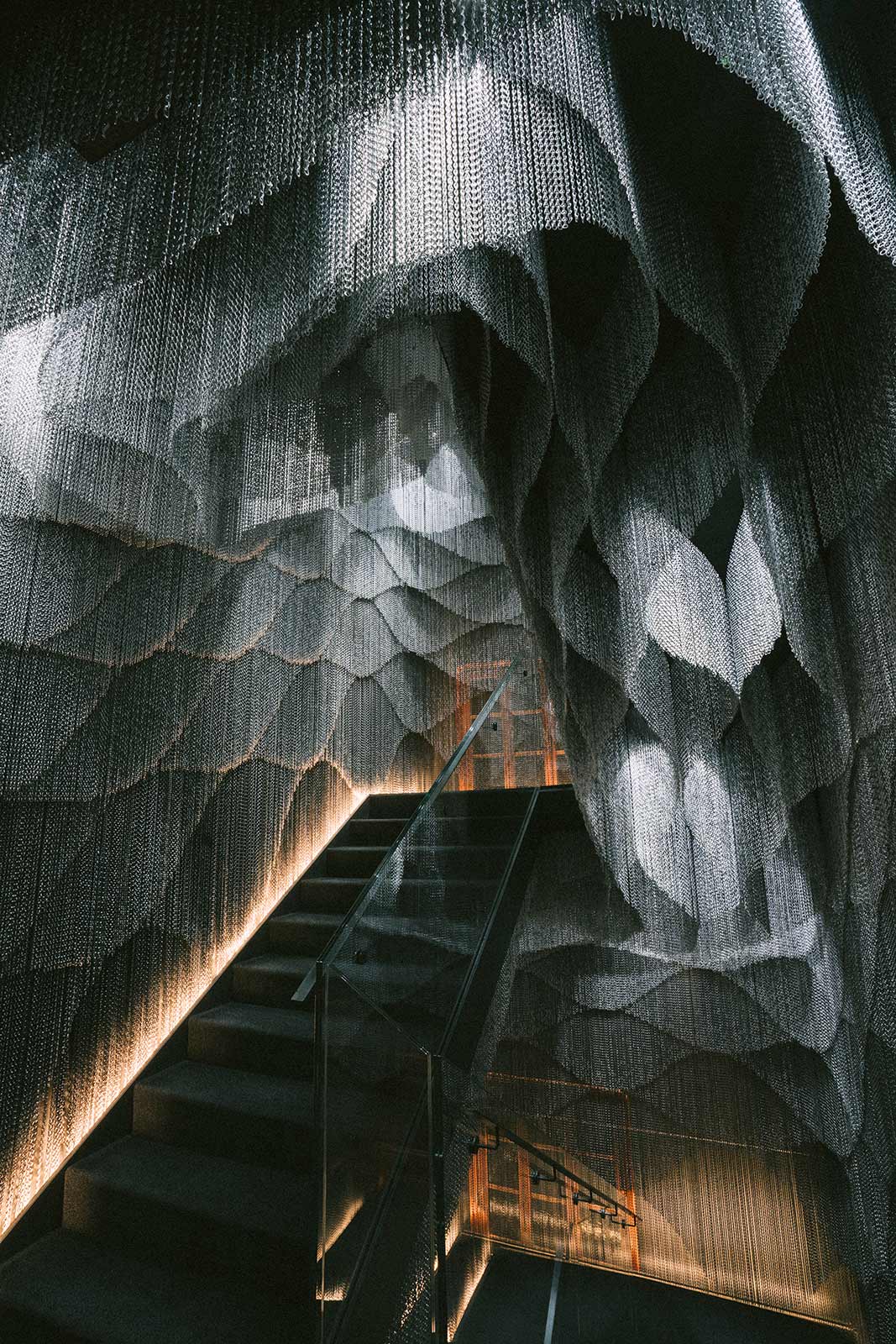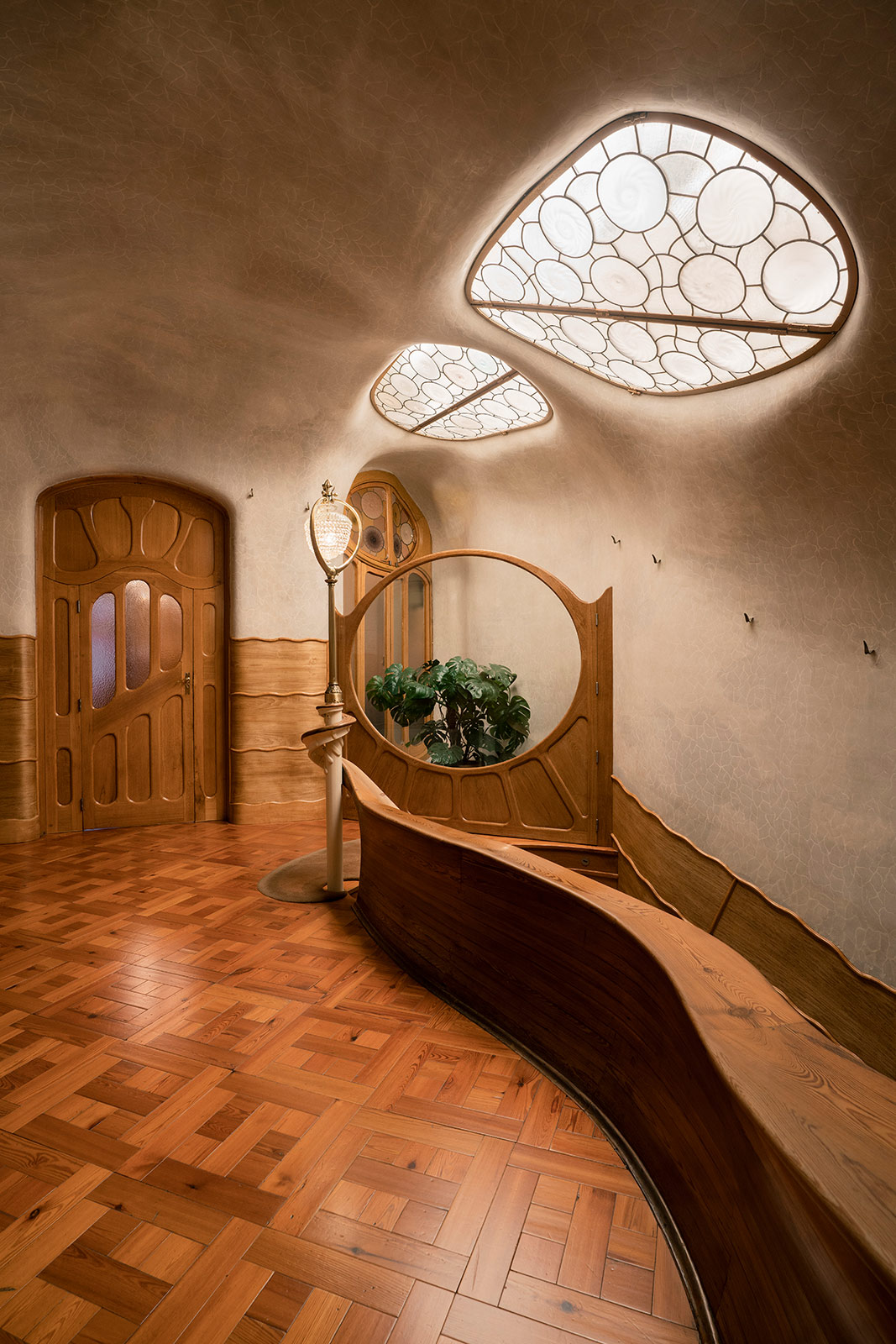In a large-scale projection mapping, neural nets help reimagine Antoni Gaudí’s Casa Batlló
Balconies become mushrooms become moss become water. Cephalopods—or so I think, although they don’t look like any creatures I recognize—unfold, 100 feet high. Then they are insects, brilliant green. The figures transform again, shifting in Sofia Crespo’s Structures of Being, a large-scale projection mapping on the Casa Batlló in Barcelona, an Antoni Gaudí residence from 1904 and now a UNESCO world heritage site.
Crespo realized this 10-minute piece in a few short months, and on January 27th and 28th, it enlivened the six-story building’s elaborate façade for nearly 100,000 viewers. With references to all sorts of more-than-human life, Structures of Being rhymes with Gaudí’s undulating surface, replete with metal, limestone, ceramics, and colored glass. Together the materials vibrate, taking on forms inspired by whale bones and seashells and skulls and plants and dragons.
In addition to working with biomorphic or “nature”-inspired forms, Gaudí often worked with scant plans—or non-traditional ones. For example, in the Sagrada Familia, he hung bags of birdshot from strings to let gravity define the shape; he then used a mirror to flip the shape on its head, turning the descending ends into what would become the basilica’s famous spires. These allegedly sui generis tricks have propelled a “genius” narrative, one well problematized by cultural critics and historians but not tourist boards (nor by a Refik Anadol video installation in the building’s basement that ends with machine-generated images coming out of the architect’s literal head). As Crespo points out, this hagiography can flatten the reality of the creative process and creative growth: “We got a crash tour of Gaudí basically,” Crespo recounts, referring to herself and Feileacan Kirkbride McCormick, her collaborator in the media-art duo Entangled Others and the technical director for Structures of Being. They toured Gaudí’s designs in Catalonia and watched “every documentary about Gaudí ever made.” But it was a visit to his first built project, the slightly inchoate Casa Vicens, that fascinated her. “The house reminded me that behind the word ‘genius’ are a lot of misconceptions about how creativity develops. This showed me he had a process and he polished a style to find what he wanted to express.” A narrative undercurrent, derived from Gaudí’s own life and artistic development, hides in the moving-image piece. The effect is subtle, but hinted at by the cinematic musical accompaniment, composed by Robert M. Thomas with the help of custom algorithms.
In Structures of Being, surface is key. To work with the complicated and ornamented façade (“not your typical project-mapping surface,” as McCormick puts it), the artists turned the building into one of the piece’s “inputs,” using a 3D model of its street-facing structure as a central element to direct neural-net-generated imagery. They also drew on it conceptually: “If you look at the façade, you’ll see bones,” Crespo points out. “Gaudí wasn’t somebody just choosing to celebrate life by looking at the things we interpret as positive. Death is part of life. Therefore, death is represented in the façade.” Likewise, while aquatic elements are typically highlighted in the blue-tiled Casa Batlló, McCormick explains that they were interested in highlighting the many species hidden in the house. “With the mapping we can show transitions and connect the dots through all these different domains from the natural world which come together in this building,” he explains. “It became a natural motor for trying to create a meditation that leads and pulls you through [those ecological domains], but without it being all at once how it is in the façade.”
By making Gaudí’s design integral to the conceptual and technological process of Structures of Being, the building can not exactly disappear, but become something else. Early in the mapping’s sequence, the entire façade appears to be a rippling surface. At other moments, it almost seems as if the building were digitally conjured, two-dimensional—or else, paradoxically, insistently material and phantasmal. There are moments where the balconies and fenestration give clear scaffolding to the plants or fungi or animals dangling from them, and other times where the architectural elements recede, the projection becoming a world unto itself. Structures of Being illuminates latent capacities in the highly articulated surface. In addition to the building itself and custom-trained AI models, Crespo also worked with inputs and visualizations created with crystallographer Waad AlBawardi and oceanography researchers associated with the Barcelona Supercomputer center to integrate data from the physical world at all scales. “The amount of footage that we rendered versus the amount of footage that we used is insane. I wish we could show all of it because there were so many amazing things we ran there, but we had to narrow it down,” Crespo laughs. “That’s what has kept me awake.”
While Gaudí’s interest in sublimating nature into architecture might have been idiosyncratic at the time, Crespo is hardly alone in thinking about how digital and biological worlds collide. “Ecology” is a popular topic for AI artists whose practices range vastly: Hito Steyerl, Anna Ridler, and Trevor Paglen have each made floral projects; previous Batlló projection artist-resident Refik Anadol has collaborated with machine-learning writer K Allado-McDowell for a nature-centric AI opera in New York; and the same weekend of Structures of Being, Manhattan space Onassis ONX presented an exhibition which PR materials described as showcasing “fresh ecologies spawn[ed] from A.I. interventions.” The concept of neural nets themselves, of course, is biomimetic. But Crespo is less interested in trying to represent reality than in representing the limits of our representations. “Datasets can be so biased and problematic,” she explains. “We can see that in the representations of various creatures, because we definitely have a hierarchy of creatures we feel comfortable with and ones we don’t.” She points out that when searching for images of octopuses online, you get a lot of them cooked, for example, which influences how AI depicts these beings. “I started thinking about how they related to humans, and human problems, which felt like an ironic way to talk about our current time, but also gives a voice to this moment.”
Crespo and McCormick train their own AI models. Currently, many mainstream generative AIs, the artists say, are “human-centric.” And, as with all AI models, training data is hardly neutral. They give the example of a jellyfish. Most people have a certain mental image of a floating, translucent being—but what about a jellyfish dead on the shore? Or what about its several other life stages? How could training data complicate or intervene in these smoothed-over understandings rather than reproduce them? Can AI instead be used for us not to consider digital/physical or analog/digital as binaries, but rather interlocking systems embedded in the world? “Anytime you watch a YouTube video physical effects are happening around the world,” McCormick points out. And these eco-digital effects aren’t just about human actions: a storm taking out a powerline has digital repercussions. “Digital space is not a neutral platonic realm. It’s part of these ecosystems.”
One of the most exciting moments of Structures of Being sheds imagery as inputs and uncovers something more essential, indeed nearly “natural,” in the process of digital-image generation itself. At first I took it as imagery trained from MRIs, or maybe scans of bacterium—colored waves and rods bulging and morphing. However, the movement had no image-signal. Generative Artificial Life, as the process is known (here done by artist Arsiliath), creates AI imagery from the shader noise of GPUs themselves; rather than being abstract, it’s perhaps the most literal digital media can get. “When working in the virtual, you have no laws of physics. You are in a realm where anything is possible,” McCormick says. “So how we approached working with the façade and creating the visuals for the façade was through simulating natural processes of different kinds, sort of working with phenomena from nature as if they were simulated.”
In Crespo’s work, as with Gaudí’s elaborate façade with its exposed skeletal elements, exteriority and interiority blends. Inspired by Gaudí’s physicality-driven design approach, Structures of Being gets at the core of human and machine inspiration, denaturalizing the idea of “nature” to help us understand the more-than-human in a digital human life. “The structure of something is always what’s hidden behind the surface,” Crespo reflects of the title. “It’s almost in contradiction with the outer layer of something.” But in this projection mapping, a surface treatment onto an elaborate surface, the facets taken as “background” become the source material. “We’re looking at how things are built and sustained on the inside.”




